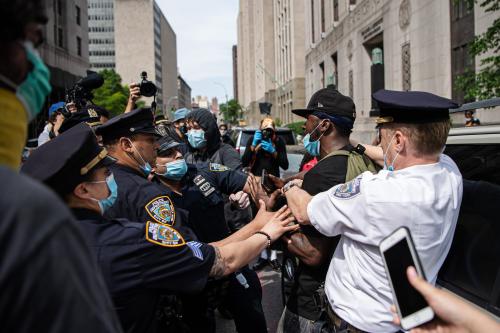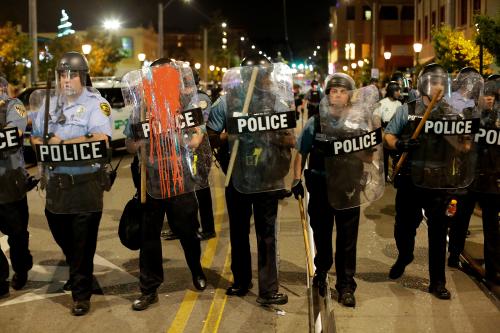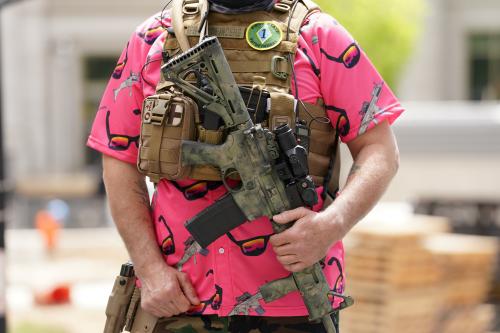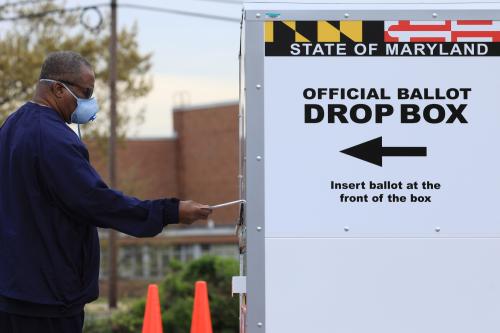The Vitals
The recent deaths of George Floyd, Breonna Taylor, and Rayshard Brooks spurred widespread protests against police brutality and racial injustices. Continuing the protests is a recent video recording of a policer officer in Kenosha, Wisc., shooting Jacob Blake, a Black man, in the back multiple times as he entered his vehicle and his children watched from inside the vehicle. Federal and local law enforcement responses to the shootings and the protests have both come under fire – but these responses are characteristic of larger law enforcement policies and institutions.
In policing, people often talk about bad apples. Well, bad apples come from rotten trees, and the rotten trees are law enforcement agencies imbued with structural racism. Standard processes for holding police officers accountable, issuing civil payouts to victims of brutality, and rehiring fired officers are a few of the factors that contribute to the entrenchment of racism and police brutality.
-
A Black person is killed about every 40 hours by police.
-
Many police departments process complaints internally. When officers police other offices, accountability is often suspect.
-
Cities and towns can increase police accountability by making police departments absorb civil payouts to victims of police violence in the form of insurance policies.
Watch
A Closer Look
Black people are 3.5 times more likely than white people to be killed by police when Blacks are not attacking or do not have a weapon. George Floyd is an example. Black teenagers are 21 times more likely than white teenagers to be killed by police. That’s Tamir Rice and Antwon Rose. A Black person is killed about every 40 hours in the United States. That’s Jonathan Ferrell and Korryn Gaines. One out of every one thousand Black men can expect to be killed by police violence over the life course. This is Tamir Rice and Philando Castile.
After Rodney King’s beating by LAPD was captured on video by a home camcorder in 1991, a series of changes were made (e.g., dash cameras in cars, body-worn cameras, and police bias trainings). However, these changes have fallen short of holding police officers accountable. Typically, officers are not charged for killing unarmed Black people. Even if they are charged, officers are almost never convicted.
Why does it take so long for officers to be charged?
Prosecutors know that the barometer for what we consider to be criminal conduct for police officers is extremely high – both legally and in the public’s perception. Most people perceive that if a police officer did something, he or she was doing it for their protection or the greater good of society. So, the bar for charging and convicting police officers is higher than the bar for regular citizens. Prosecutors, then, often take more time to ensure that a case is solid before they bring charges.
In Minneapolis, the time it took for charges to be brought against the officers in the George Floyd case was abnormally short. In recent events — from Christian Cooper in Central Park to Ahmaud Arbery in Georgia to George Floyd in Minneapolis — smart phone video was collected by civilians. Once video evidence was disseminated on social media, the criminal process moved more expeditiously. Most of the time, however, police officers are allowed time to consult with the Fraternal Order of Police and a lawyer, and, at times, even review evidence before officials make public statements.
Why are bad-acting cops allowed to stick around?
Derek Chauvin, the officer who killed George Floyd, has been involved in at least 18 police misconduct cases. He’s been involved in police shootings, and he’s been involved in cases that most people consider to be police brutality. What’s important is that this is a pattern. The officers who killed Tamir Rice in Cleveland in 2014, and who killed Antwon Rose in East Pittsburgh in 2018—both Black teenagers—were dismissed from previous jobs as police officers. When an officer is dismissed, typically the Fraternal Order of Police has helped them resign quietly instead of being fired. This gives bad officers the ability to work for another department. This needs to change.
Complaints of misconduct within police departments often go to internal affairs. The complaint goes up the chain, and if it makes all the way up, it goes to a trial board that typically involves three officers who decide if the accused officers have engaged in misconduct. The trial board serves as judge and jury of their own. An officer must do something extremely egregious to be fired. But, there are other types of reprimand. Officers can be put on desk duty, paid or unpaid leave, or fined at a prorated amount in future paychecks. The problem is that all these actions are typically internal to policing. They are rarely known outside the department until long after the incident and the conduct decision. And, my research shows that Black officers are sanctioned more harshly than white officers for similar misconduct.
When does the Civil Rights Division of the U.S. Justice Department get involved?
The Department of Justice often has to be invited in by the state. In the Ahmaud Arbery case, the local prosecutor invited in the Georgia Bureau of Investigation. The Georgia Attorney General then asked the U.S. Department of Justice to investigate the behavior of two district attorneys previously assigned to the case. The U.S. Department of Justice also was investigating whether the killing was a hate crime. In the George Floyd case, the Federal Bureau of Investigation investigated “to determine whether any federal civil rights laws were violated.” The murder case is also being prosecuted at the state level similar to the Arbery case.
When Dylann Roof murdered nine parishioners at Emanuel AME Church in Charleston, South Carolina, federal authorities brought hate crime charges. And this is important, because there are states—Georgia, for instance—that don’t have hate crime laws. If hate crime charges are going to be brought in the Arbery murder, they must be brought at the federal level. In Floyd’s case, hate crime charges could be brought on the state and/or federal levels.
What reforms could change police accountability?
My research offers two major changes to law and practice to reduce police brutality. First, officers who have been terminated due to police misconduct should not be able to work in law enforcement again. This recommendation is receiving bipartisan support at the federal level. It is part of Trump’s recent Executive Order and the George Floyd Justice in Policing Act that passed in the House of Representatives.
Second, we need to restructure civilian payouts by moving them from taxpayer money to police department insurance policies. This is starting to occur in some ways at the local level. New York state lawmakers proposed that individual officers carry liability insurance.
Eventually, there will be a large civil payout for the death of George Floyd. The Floyd family’s taxpayer money will be used to pay them for his dehumanization and killing. Due to qualified immunity—the legislation that often prevents officers from facing civil culpability—officers are typically immune from the financial impacts of these civil payouts. Since 2010, St. Louis has paid over $33 million and Baltimore was found liable for about $50 million for police misconduct. Over the past 20 years, Chicago spent over $650 million on police misconduct cases. In one year from period from July 2017 through June 2018, New York City paid out $230 million in about 6,500 misconduct cases. What if this money was used for education and work infrastructure? Research suggests that crime would decrease.
In health care, mistakes happen. But, physicians and hospitals have malpractice insurance. In law enforcement, when there is a mistake, the city is typically on the hook. Even though the city (and thus its taxpayers) would cover the police department’s malpractice insurance premium, when the city’s malpractice premium goes up, the city will know which police officers, like which physicians and which hospitals, are responsible. This gives cities and departments a market-driven approach to weed out bad apples so they don’t continue to rot the trees of law enforcement agencies.
This was adapted from a podcast interview with the author.








Commentary
How can we enhance police accountability in the United States?
August 25, 2020